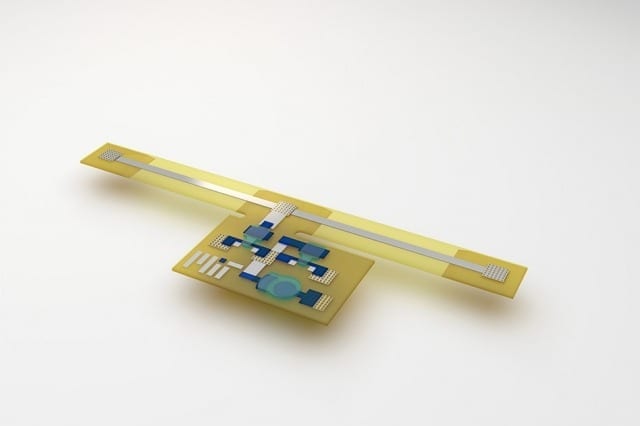
University of Sydney researchers have used infrared spectroscopy to spotlight changes in tiny cell fragments called microvesicles to probe their role in a model of the body’s immunological response to bacterial infection.
While more research is needed to confirm the findings published today in the FASEB Journal, the use of FTIR spectroscopy could herald a fast and easy way to spot early signs of infection, cancer, and difficult to diagnose neurological conditions.
The research led by Professors Peter Lay and Georges Grau used Fourier transform infrared (FTIR) spectroscopy to detect and characterize the release of sub-micron sized microvesicles.
Produced from the cell membranes of mammals, microvesicles play a role in cell communication and carry a “cargo” of RNA, DNA, proteins, lipids and other biomolecules that they use to dramatically change the biochemistry of other cells.
Microvesicles are involved in normal physiology but are released into the bloodstream at higher levels during the acute and early development phase of many diseases. They are also potent vectors and mediators of disease, so detecting changes in their number and biochemistry could be helpful for spotting mechanisms of early diseases development.
The researchers used FTIR spectroscopy to monitor microvesicle-biomolecular changes in white blood cells, known as monocytes, they stimulated with a component of deadly bacteria called lipopolysaccharide, comparing the changes to those in healthy, uninfected white blood cells.
Lipopolysaccahride from various bacteria can reach the blood and cause septic shock, a life-threatening complication of sepsis where the body’s infection-response can injure tissues and organs.
“We found a threefold increase in the number of microvesicles from white blood cells stimulated with lipopolysaccharide that points to a pathophysiological role for these microvesicles in bacterial infection and its subsequent immune response,” said study co-author Georges Grau at the University of Sydney’s Vascular Immunology Unit and Marie Bashir Institute for Infectious Diseases.
“We also saw clear biomolecular changes – more lipids and proteins – in microvesicles produced by white blood cells stimulated by lipopolysaccharides, compared to those produced by resting white blood cells.”
The researchers also discovered that most of the “cargo” of RNA, DNA, lipids and proteins released by the white blood cells were contained within these microvesicles.
“This is very important since there is an enormous research effort looking at circulating RNA, DNA and proteins in blood as diagnostics of diseases and our results indicate that they are mostly carried in these microvesicles,” said senior author, Professor Peter Lay at the University’s School of Chemistry and Vibrational Spectroscopy Core Facility.
“In many respects, the microvesicles released under bacterial stimulation during an infectious episode are like viruses whereby the altered lipid content and increases and proteins appear designed to invade and change the biochemistry of target cells by releasing their DNA and RNA.
“This use of FTIR spectroscopy to analyse microvesicles provides a new way characterize the biomolecular differences in this model of septic shock-induced white blood cell-microvesicle and could easily be applied to other models of microvesicle release, notably in a range of inflammatory diseases.”
Learn more: Research spotlights early signs of disease using infrared light
[osd_subscribe categories=’FTIR-spectroscopy’ placeholder=’Email Address’ button_text=’Subscribe Now for any new posts on the topic “FTIR SPECTROSCOPY”‘]
The Latest on: FTIR spectroscopy
[google_news title=”” keyword=”FTIR spectroscopy” num_posts=”10″ blurb_length=”0″ show_thumb=”left”]
via Google News
The Latest on: FTIR spectroscopy
- HTS-XT Microplate Extension from Brukeron May 3, 2024 at 5:01 pm
Bruker’s microplate extension HTS-XT allows the application of FTIR spectroscopy as technique for high-throughput screening. The acquisition, control and assessment of spectral data from ...
- VERTEX 80/80v FTIR Spectrometer from Brukeron May 3, 2024 at 5:01 pm
of better 300,000:1 is demonstrated by high resolution spectra in the visible spectral range. The innovative optics design results in the most expandable and flexible R&D vacuum FTIR spectrometer ...
- Fourier transform infra-red spectroscopy models unravel cell wall composition and nutritional quality in buffel grasson April 25, 2024 at 10:09 am
A research team developed Fourier transform infra-red (FTIR) spectroscopy-based partial least squares regression (PLSR) models to assess Cenchrus spp (buffel grass) accessions, discovering significant ...
- How To Test Photovoltaic Cells Using FTIR and UV Spectroscopy Techniqueson March 9, 2024 at 6:15 am
During this webinar, we will investigate how FTIR and UV spectroscopy can be used in a number of materials testing areas including material degradation, surface cleanliness, material identification ...
- Fourier Transform Infrared Spectroscopy (FTIR)on February 16, 2024 at 2:30 pm
Definition: Fourier Transform Infrared (FTIR) Spectroscopy is a highly specialized type of IR spectroscopy. It's the most common way IR measurements are carried out today. FTIR is known for its speed, ...
- Infrared Spectroscopyon August 16, 2023 at 2:51 am
The ability to detect a tumor earlier, when it is smaller, reduces the impact of surgery and treatment, improving the prognosis for many patients. Dxcover has developed a new spectroscopic liquid ...
- High Pressure, High Temperature (HTHP) Cell for FTIR Spectroscopyon August 12, 2023 at 7:24 pm
Cell Accessory offered by Specac is a multipurpose cell developed for the FTIR analysis of solid samples in decomposition, transmission, or specular reflectance modes. Users can achieve sample ...
- Frequency-comb spectroscopyon February 25, 2021 at 4:06 am
The PAS cell is placed inside a scanning Michelson interferometer, which makes it possible to simultaneously record all molecular absorption lines that fall within the comb spectrum, analogous to ...
- Thermo Nicolet iS50 bench FTIR spectrometeron January 18, 2021 at 10:15 am
Fourier Transform Infrared (FTIR) spectroscopy is used to identify and analyse minerals, organic and man-made materials. Infrared radiation is passed through the sample. A detector is used to measure ...
via Bing News











